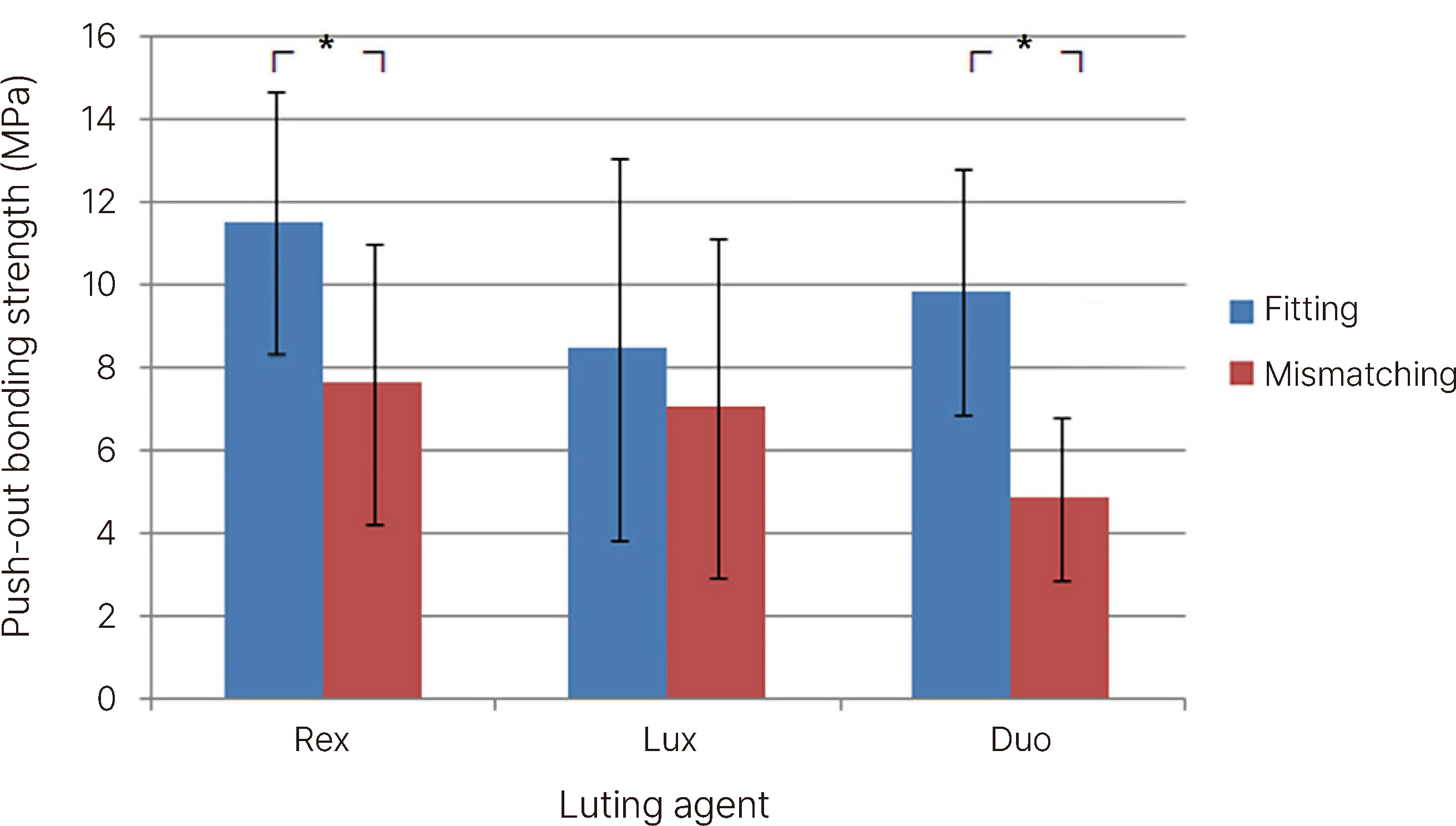J Dent Rehabil Appl Sci.
2023 Dec;39(4):187-194. 10.14368/jdras.2023.39.4.187.
The influence of fitness and type of luting agents on bonding strength of fiber-reinforced composite resin posts
- Affiliations
-
- 1Department of Conservative Dentistry, School of Dentistry, Chonnam National University, Gwangju, Republic of Korea
- 2Moa Dental Clinic, Seoul, Republic of Korea
- KMID: 2550427
- DOI: http://doi.org/10.14368/jdras.2023.39.4.187
Abstract
- Purpose
A mismatched size in the post and post space is a common problem during post-fixation. Since this discordance affects the bonding strength of the fiber-reinforced composite resin post (FRC Post), a corresponding luting agent is required. The aim of this study was to evaluate the bonding strength of the FRC post according to the fitness of the fiber post and the type of luting agent. Materials and Methods: Thirty mandibular premolar were endodontic-treated and assigned to two groups according to their prepared post space: Fitting (F) and Mismatching (M). These groups were further classified into three subgroups according to their luting agent: RelyX Unicem (ReX), Luxacore dual (Lux), and Duolink (Duo). A push-out test was performed to measure the push-out bond strengths. The fractured surfaces of each cross-section were then examined, and the fracture modes were classified.
Results
In the ReX and Duo subgroups, the F group had a higher mean bond strength; however, the Lux subgroup had no significant difference between the F and M groups. In the analysis of the failure modes, the ReX subgroup had only adhesive failures between the cement and dentin. Conclusion: The result of this study showed that the bond strength of an FRC post was influenced by the type of luting agent and the mismatch between the diameter of the prepared post space and that of the post.
Figure
Reference
-
References
1. Malferrari S, Monaco C, Scotti R. 2003; Clinical evaluation of teeth restored with quartz fiber-reinforced epoxy resin posts. Int J Prosthodont. 16:39–44. PMID: 12675453.2. Asmussen E, Peutzfeldt A, Heitmann T. 1999; Stiffness, elastic limit, and strength of newer types of endodontic posts. J Dent. 27:275–8. DOI: 10.1016/S0300-5712(98)00066-9. PMID: 10193104.3. Torbjörner A, Karlsson S, Odman PA. 1995; Survival rate and failure characteristics for two post designs. J Prosthet Dent. 73:439–44. DOI: 10.1016/S0022-3913(05)80072-1. PMID: 7658393.4. Grandini S, Goracci C, Monticelli F, Tay FR, Ferrari M. 2005; Fatigue resistance and structural characteristics of fiber posts: three-point bending test and SEM evaluation. Dent Mater. 21:75–82. DOI: 10.1016/j.dental.2004.02.012. PMID: 15681005.5. Moosavi H, Maleknejad F, Kimyai S. 2008; Fracture resistance of endodontically-treated teeth restored using three root-reinforcement methods. J Contemp Dent Pract. 9:30–7. DOI: 10.5005/jcdp-9-1-30. PMID: 18176646.6. Erkut S, Gulsahi K, Caglar A, Imirzalioglu P, Karbhari VM, Ozmen I. 2008; Microleakage in overflared root canals restored with different fiber reinforced dowels. Oper Dent. 33:96–105. DOI: 10.2341/07-47. PMID: 18335739.7. Perdigão J, Gomes G, Augusto V. 2007; The effect of dowel space on the bond strengths of fiber posts. J Prosthodont. 16:154–64. DOI: 10.1111/j.1532-849X.2006.00166.x. PMID: 17581176.8. D'Arcangelo C, Cinelli M, De Angelis F, D'Amario M. 2007; The effect of resin cement film thickness on the pullout strength of a fiber-reinforced post system. J Prosthet Dent. 98:193–8. DOI: 10.1016/S0022-3913(07)60055-9. PMID: 17854620.9. Nissan J, Dmitry Y, Assif D. 2001; The use of reinforced composite resin cement as compensation for reduced post length. J Prosthet Dent. 86:304–8. DOI: 10.1067/mpr.2001.114759. PMID: 11552168.10. Barfeie A, Thomas MB, Watts A, Rees J. 2015; Failure Mechanisms of Fibre Posts: A Literature Review. Eur J Prosthodont Restor Dent. 23:115–27.11. Goracci C, Sadek FT, Fabianelli A, Tay FR, Ferrari M. 2005; Evaluation of the adhesion of fiber posts to intraradicular dentin. Oper Dent. 30:627–35. PMID: 16268398.12. Bouillaguet S, Troesch S, Wataha JC, Krejci I, Meyer JM, Pashley DH. 2003; Microtensile bond strength between adhesive cements and root canal dentin. Dent Mater. 19:199–205. DOI: 10.1016/S0109-5641(02)00030-1. PMID: 12628431.13. Tay FR, Gwinnett AJ, Pang KM, Wei SH. 1995; Variability in microleakage observed in a total-etch wet-bonding technique under different handling conditions. J Dent Res. 74:1168–78. DOI: 10.1177/00220345950740050501. PMID: 7790594.14. Goracci C, Fabianelli A, Sadek FT, Papacchini F, Tay FR, Ferrari M. 2005; The contribution of friction to the dislocation resistance of bonded fiber posts. J Endod. 31:608–12. DOI: 10.1097/01.don.0000153841.23594.91. PMID: 16044046.15. Hayashi M, Okamura K, Wu H, Takahashi Y, Koytchev EV, Imazato S, Ebisu S. 2008; The root canal bonding of chemical-cured total-etch resin cements. J Endod. 34:583–6. DOI: 10.1016/j.joen.2008.02.003. PMID: 18436039.
- Full Text Links
- Actions
-
Cited
- CITED
-
- Close
- Share
- Similar articles
-
- Retentive bond strength of fiber-reinforced composite posts cemented with different surface treatments
- Mechanical properties related to the microstructure of seven different fiber reinforced composite posts
- Currently there are so many fiber reinforced composite posts in the market. Some products are factory silanated but some products are not. Should I use silane for surface treatment of fiber reinforced composite posts?
- Comparison between a bulk-fill resinbased composite and three luting materials on the cementation of fiberglass-reinforced posts
- Influence of airborne-particle abrasion on flexural strength of fiber-reinforced composite post


